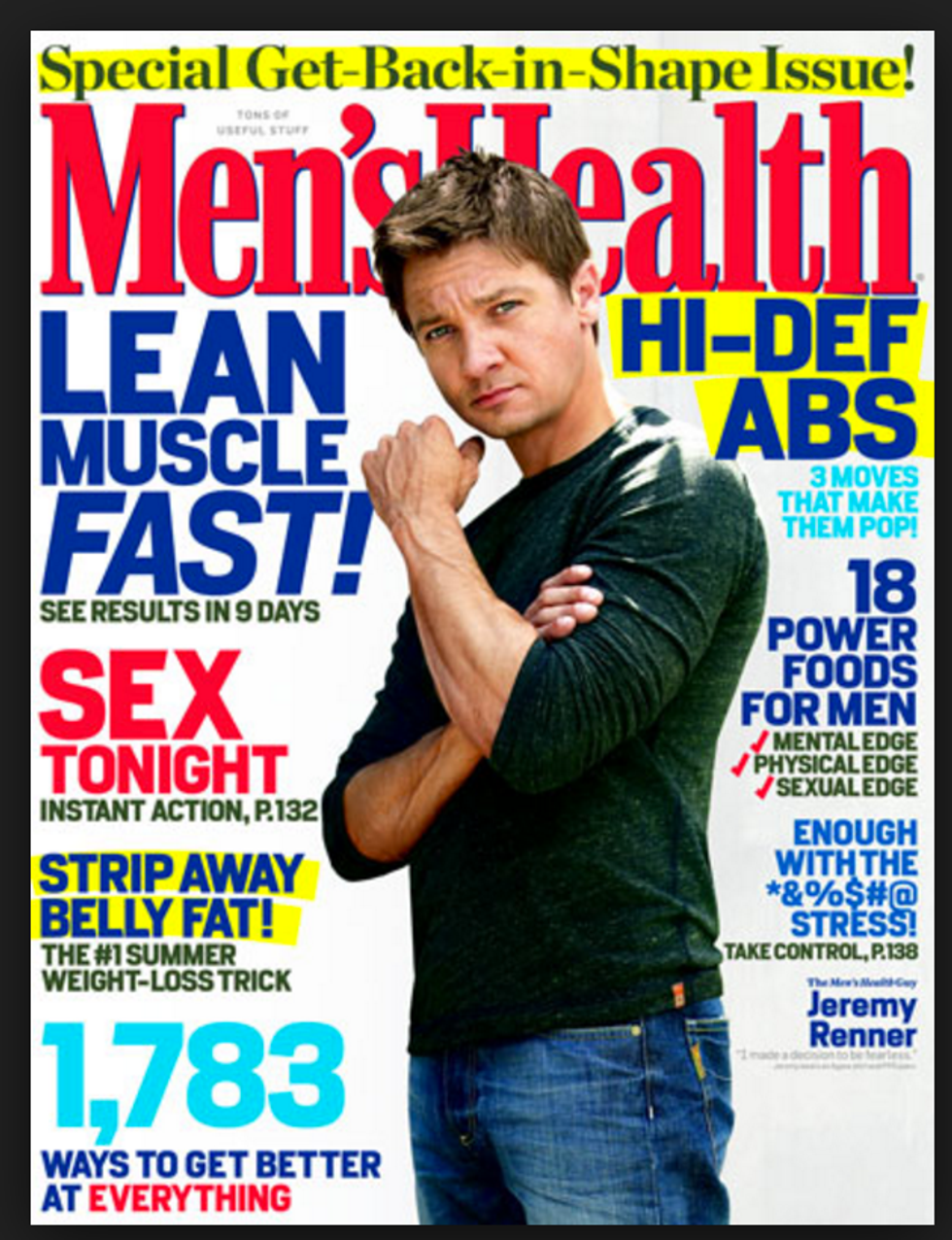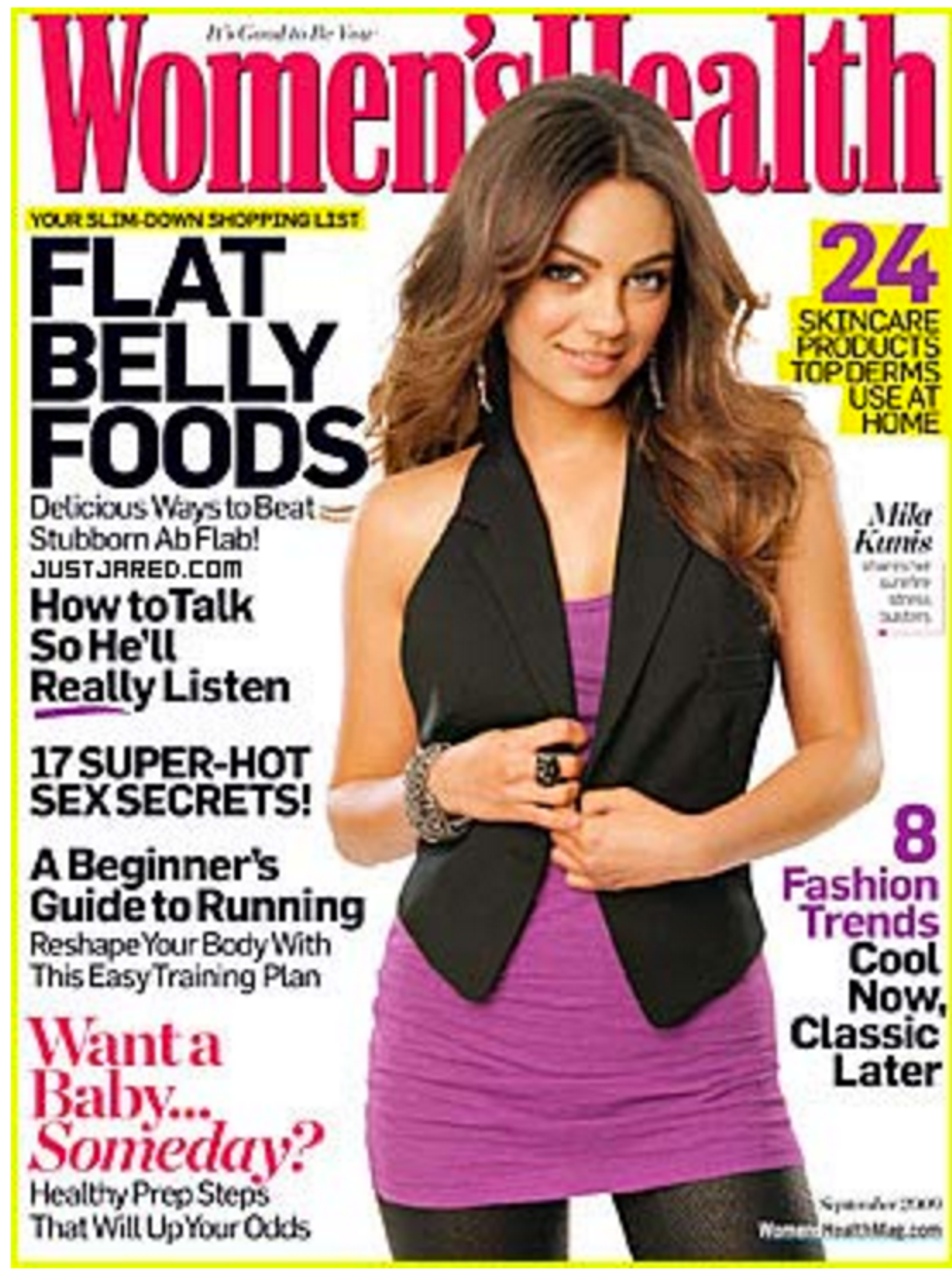If you've ever looked at a magazine rack, chances are that you've noticed, or at least registered subconsciously, the difference between magazines that are advertised to men and magazines that are advertised to women. Men's magazines tend to have darker background colors, and usually feature either a hyper-masculine "hunky" man and his muscles, or a scantily-clad woman posing in some unnatural position. Women's magazines, on the other hand, tend to have lighter background colors, and feature "ideal-looking" women who conform to today's unreachable and unreasonable standards of beauty - that is to say, women who are slim, toned, shiny-haired, and tan-skinned. Often these men and women are celebrities, and it is almost without question that they are airbrushed and photoshopped.
Why is it necessary to portray people in this distorted way? The simple answer is that magazines want to sell things. It would seem as though the best way to do that is to make people feel like they need whatever is being advertised, like they cannot achieve what they want to achieve without having and using the product or the tips that the magazine suggests. As a woman, when I see magazines that feature seemingly-perfect celebrities, I feel uncomfortable, inferior, or like I’m not enough, because I don’t look like the girl on the cover. In reality, I know that nobody looks like her; she doesn’t even look like her cover image! But that doesn’t stop me from registering the perfected photograph and feeling self-conscious about my body and my lifestyle, if even for just one second.
Besides making people feel inferior because of how celebrities are portrayed on their covers, magazines also make people feel inferior because of their exclusion from the cover images. Rarely do magazines feature people who are transgendered, gender-fluid, or agender. This is problematic because it serves to "other" people who do not conform to society's hetero-centric, cisgender-assuming culture, as well as further the stigma against them.
The way that women are portrayed on magazine covers only functions to further the media's stereotypes about women - that women are sexual objects that are meant to be overpowered and controlled - while also playing into and sustaining rape culture, in which women are often blamed and "slut shamed" for wearing certain things or acting and dancing in certain ways. The media both creates and perpetuates rape culture by portraying women wearing minimal clothing in overly sexual poses on magazines and widely-viewed images, causing people to expect women to act and dress in certain ways in real life. However, people also expect women to be traditionally "lady-like" in real life, and playing both of these roles at the same time is impossible and unrealistic.
This stereotyping doesn't just apply to women, though. Men also tend to be stereotyped, in that unless you are seeing "before and after" shots, men's magazine covers tend to only feature muscular, tan men in poses that show off their (usually photoshopped) over-toned arms, abs, or legs. This serves to further the expectation that men are supposed to be strong in order to be considered "manly," yet another media-created assumption causing discomfort and a lack of sense of self-worth in men who do not look like men on magazine covers.
Women's magazines tend to include content about hair and makeup, exercises for a "flat belly" or "toned butt," home decoration tips, recipes and sex tips. Seeing these words (ex. flat, toned, sex, home decoration) on magazine covers only perpetuates the stereotype of women as hyper-sexualized beings that belong in the home, specifically the kitchen. (Recently one of my friends wore a great shirt that said, "Women belong in the House and the Senate." This shirt both points out and rejects the stereotype of women belonging only in the home. Instead of sexual images of women, why don't we see more powerful images of women? Pictures and illustrations of hard-working, high-achieving women would do far more to inspire women than what we see nowadays in the media.)
Though men's magazines also include tips about sex and body building, the ways that men's magazines write the tips differ greatly. Men's magazines tend to feature articles about getting "instant action" and having "sex tonight," insinuating that if a man were to do a few specific things, then he would definitely get to sleep with a woman "tonight!". This kind of language suggests that women are prizes, or objects to be conquered and used! Personally, I find this kind of word choice rude, and, frankly, offensive.
In addition to the sexist language that the magazine uses to insinuate certain things about women, men's magazines also utilize language that seems to assume that all men are stressed (see: “Enough With The *&%$#@ Stress!”), trying to exercise and get strong (see: “Lean Muscle Fast!”, “Hi-Def Abs”, and “Strip Away Belly Fat!”), having or wanting sex every night (see: “Sex Tonight, Instant Action”), and needing to be "the best" at everything they do (see: 1,783 Ways To Get Better At Everything”). This is also sexist, in that it is making generic assumptions about men, stereotyping them into controlling, gym-obsessed, self-involved sex monsters. In the same way that when I walk by a magazine that insinuates that I am not good enough, this kind of language and imagery on men's magazine makes most average men feel worthless. It serves to tell men that they are inferior unless they are strong, calm, and in control, and gives an untrue portrayal of what life is really like for men.
Similar to what Men’s Health does for (or, really, to) men, the magazine Woman's Health, gives women all the tips they are assumed to need on an everyday basis... that is, all the tips that they need in order to be taken seriously by their man, as if they wouldn't be otherwise (see: "How to Talk So He'll Really Listen.") It also includes all the tips women will need in order to learn how to run, and tone their body, because obviously they didn't know how before, and because their body needs toning (see: "A Beginner's Guide to Running, Reshape Your Body With This Easy Training Plan".) Additionally, the magazine features all the tips women need to get themselves ready to have a baby at some point, because, naturally, they are going to want to get pregnant eventually, and need to get started early (see: Want a baby...Someday? Healthy Prep Steps that Will Up Your Odds.") Not only does this magazine's cover do a horrible job of actually promoting healthy living styles for women, it also stereotypes and stigmatizes women. Women are sexualized, objectified, and dehumanized, making them seem like ignorant objects that exist solely for the purpose of sexually pleasing their man and looking good for others.These magazine covers are just two examples of the over-sexualization of women and hyper-masculinization of men in media. This kind of advertising only serves to perpetuate the gender binary, as well as create and further unrealistic assumptions of how men and women should look and behave. If we are ever to be able to call ourselves a socially-modern society, we must include and celebrate people in all ways, shapes and forms, no matter what their gender, sexual orientation, skin color, or body type, in all forms of media. If we ever want to change society's unreachable beauty standards for girls and women, as well as the unrealistic expectations placed upon boys and men, we first have to change the way that people are portrayed and seen in the media, and stop emphasizing the over-sexualization of women and the over-masculinization of men.


























